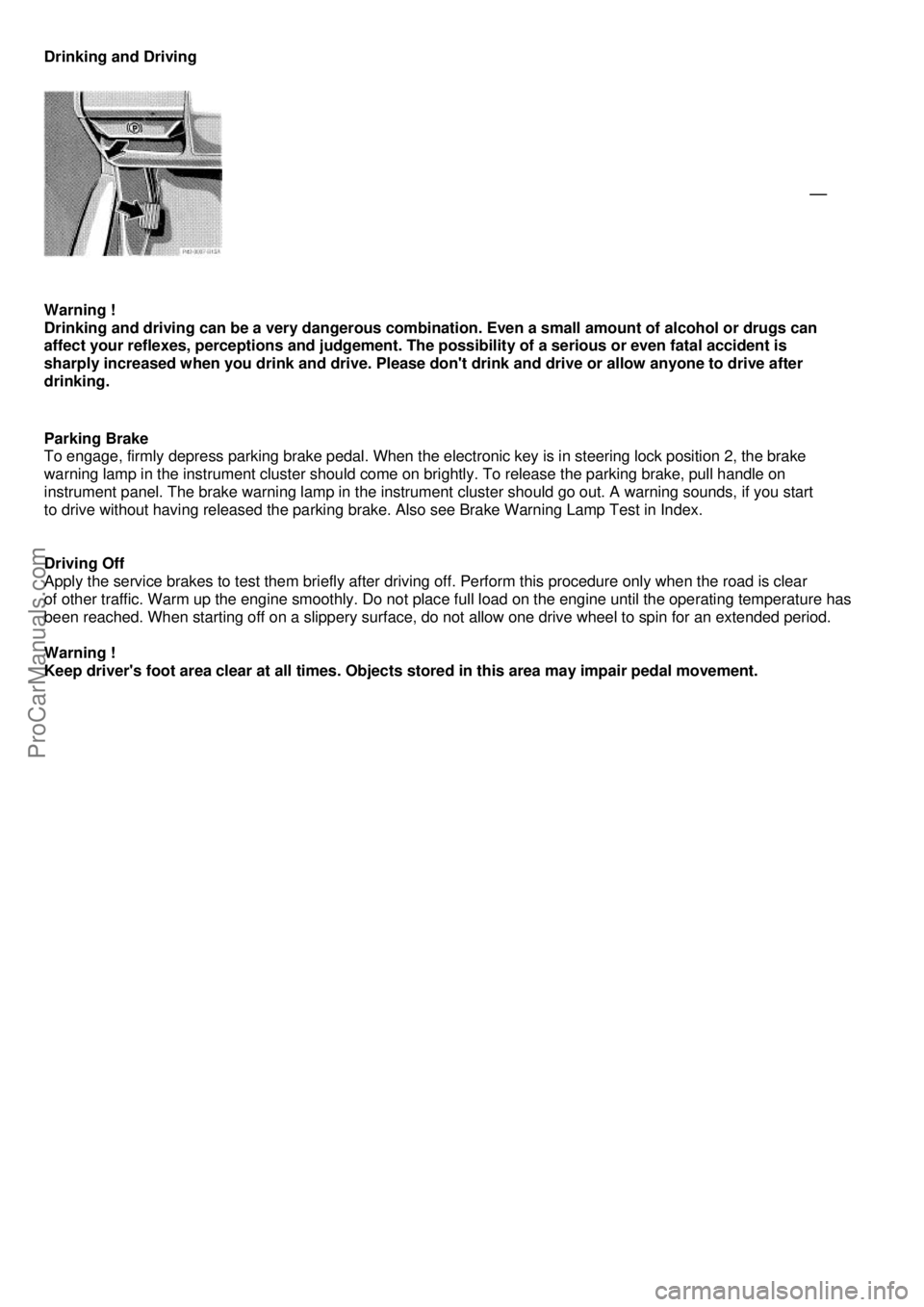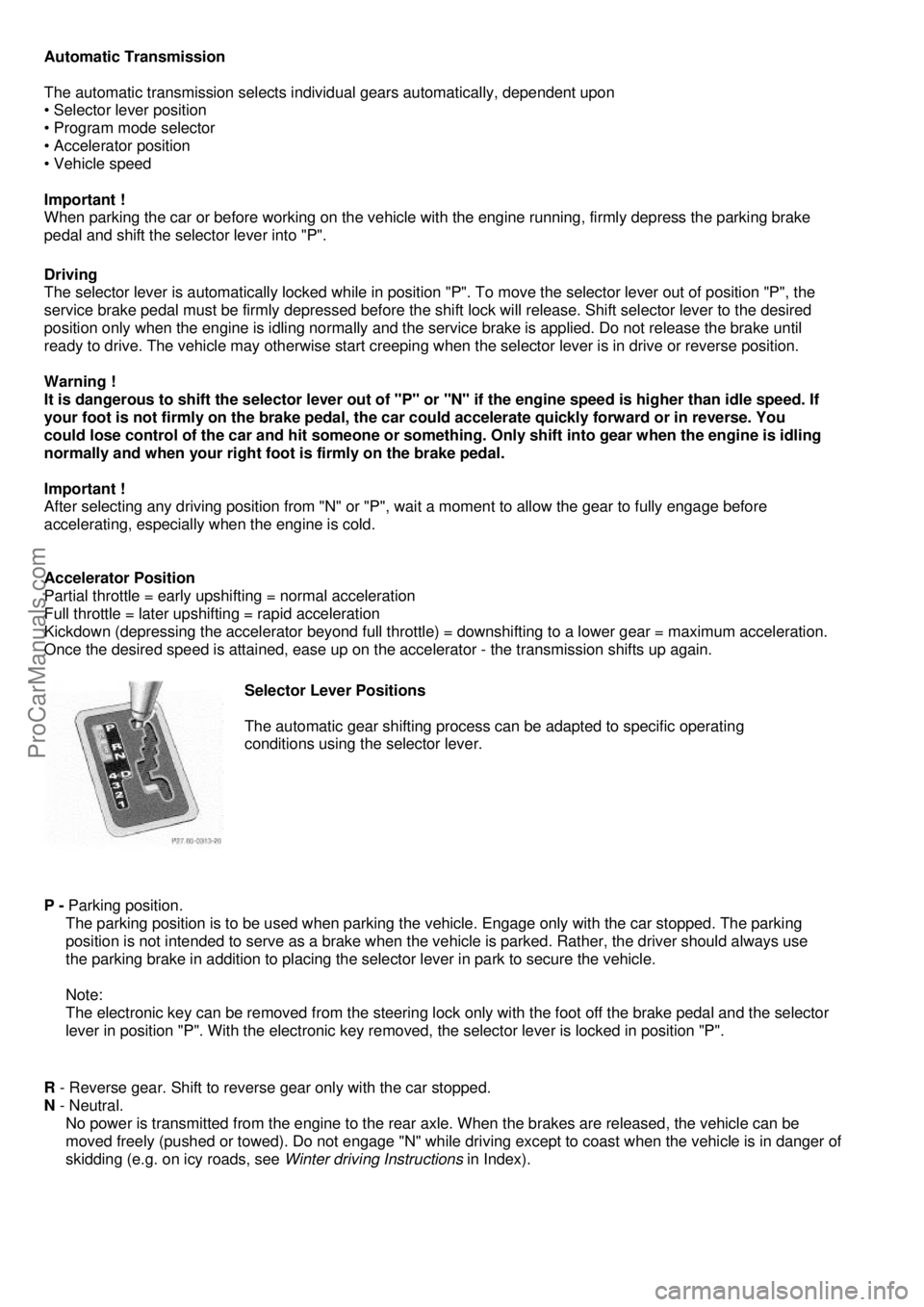1999 MERCEDES-BENZ C-280 steering
[x] Cancel search: steeringPage 58 of 122

Garage Door Opener
1. Remote control transmitter located on driver side sun visor
2. Portable remote control transmitter
Warning !
When programming a garage door opener, the door moves up or down. When programming or operating
the remote control make sure there is no possib ility of anyone being harmed by the moving door.
The visor remote control is capable of operati ng up to three separately controlled objects.
Notes:
Certain types of garage door openers are incompatible wi th the integrated opener. If you should experience
difficulties
with programming the transmitter, contact your authoriz ed Mercedes-Benz dealer or call Mercedes-Benz Customer
Assistance Center (in the U.S.A. only) at 1-800-FOR- MERCedes. For operation in the USA only: This devise
complies
with Part 15 of the FCC Rules. Operation is subject to the following two conditions:
(1) This device may not cause harmful interference, and (2) this device must accept any interference received,
including interference that may cause undesired operation. Any unauthorized modification to this device could void
the user's
authority to operate the equipment.
Programming or reprogramming the remote control:
1. Turn electronic key in steering lock to position 1 or 2.
2. Press and hold one button of the remote control located on the sun visor until its control light begins to flash at a
rate of about once a second. Continue holding down the button.
Note:
The light blinks immediately if the remote control is being programmed for the first time, or if its memory was
previously erased. If you are re programming a previously used button, the light will flash afte r about 20 seconds.
3. Hold end opposite to battery of portable remote contro l against the sun visor transmitter to be programmed. While
still holding down the button on the transmitter on the sun visor, press down the button on your portable remote
control, until the sun visor remote control light starts to flash rapidly. This means that the integrated remote control
has accepted the frequency and code of the portable transmitter.
4. If you wish, repeat the procedure for each remaining button.
Operation of remote control:
1. Turn electronic key in steering lock to position 1 or 2.
2. Select and press the appropriate button (1, 2 or 3) to ac tivate the remote controlled device. The remote control
transmitter continues to send the signal as long as the button is pressed - up to 20 seconds.
Erasing the remote control memory:
1. Turn electronic key in steering lock to position 1 or 2.
2. Simultaneously holding down buttons 1 and 3 for approximatel y 20 seconds, or until the control light blinks rapidly,
will erase the code s of all three channels.
ProCarManuals.com
Page 62 of 122

Drinking and Driving
Warning !
Drinking and driving can be a very dangerous combination. Even a small amount of alcohol or drugs can
affect your reflexes, perceptions and judgement. The possibility of a serious or even fatal accident is
sharply increased when you drink and drive. Please don't drink and drive or allow anyone to drive after
drinking.
Parking Brake
To engage, firmly depress parking brake pedal. When the electronic key is in steering lock position 2, the brake
warning lamp in the instrument cluster should come on brightly. To release the parking brake, pull handle on
instrument panel. The brake warning lamp in the instrument cluster should go out. A warning sounds, if you start
to drive without having released the parking brake. Also see Brake Warning Lamp Test in Index.
Driving Off
Apply the service brakes to test them briefly after driving off. Perform this procedure only when the road is clear
of other traffic. Warm up the engine smoothly. Do not plac e full load on the engine until the operating temperature has
been reached. When starting off on a slippery surface, do not allow one drive wheel to spin for an extended period.
Warning !
Keep driver's foot area clear at all times. Object s stored in this area may impair pedal movement.
ProCarManuals.com
Page 63 of 122

Automatic Transmission
The automatic transmission selects individual gears automatically, dependent upon
• Selector lever position
• Program mode selector
• Accelerator position
• Vehicle speed
Important !
When parking the car or before working on the vehicle with the engine running, firmly depress the parking brake
pedal and shift the selector lever into "P".
Driving
The selector lever is automatically locked while in position "P". To move the selector lever out of position "P", the
service brake pedal must be firmly depressed before the shift lock will release. Shift selector lever to the desired
position only when the engine is idling normally and the service brake is applied. Do not release the brake until
ready to drive. The vehicle may otherwise start creeping when the selector lever is in drive or reverse position.
Warning !
It is dangerous to shift the selector lever out of "P" or "N" if the engine speed is higher than idle speed. If
your foot is not firmly on the brake pedal, the car could accelerate quickly forward or in reverse. You
could lose control of the car and hit someone or something. Only shift into gear when the engine is idling
normally and when your right foot is firmly on the brake pedal.
Important !
After selecting any driving position from "N" or "P", wait a moment to allow the gear to fully engage before
accelerating, especially when the engine is cold.
Accelerator Position
Partial throttle = early upshifting = normal acceleration
Full throttle = later upshifting = rapid acceleration
Kickdown (depressing the accelerator beyond full throttle) = downshifting to a lower gear = maximum acceleration.
Once the desired speed is attained, ease up on t he accelerator - the transmission shifts up again.
Selector Lever Positions
The automatic gear shifting process can be adapted to specific operating
conditions using the selector lever.
P - Parking position.
The parking position is to be used when parking t he vehicle. Engage only with the car stopped. The parking
position is not intended to serve as a brake when the vehicle is parked. Rather, the driver should always use
the parking brake in addition to placing the selector lever in park to secure the vehicle.
Note:
The electronic key can be removed from the steering lo ck only with the foot off the brake pedal and the selector
lever in position "P". With the electronic key removed, the selector lever is locked in position "P".
R - Reverse gear. Shift to reverse gear only with the car stopped.
N - Neutral.
No power is transmitted from the engine to the rear axle. When the brakes are released, the vehicle can be
moved freely (pushed or towed). Do not engage "N" while driving except to coast when the vehicle is in danger of
skidding (e.g. on icy roads, see Winter driving Instructions in Index).
ProCarManuals.com
Page 66 of 122

Cruise Control
Cruise Control
Any given speed above approximately 22 mph (35 km/h) can be maintained with the cruise control by operating the
lever.
1. Accelerate and set:
Lift lever briefly to set speed. Hold lever up to accelerate.
2. Decelerate and set:
Depress lever briefly to set sp eed. Hold lever down to decelerate.
Normally the vehicle is accelerated to the desired speed with the accelerator. Speed is set by briefly pushing
the lever to position 1 or 2. The accelerator can be released. The speed can be increased (e.g. for passing)
by using the accelerator. As soon as the accelerator is released, the previously set speed will be resumed
automatically. If a set speed is to be increased or decreased slightly, e.g. to adapt to the traffic flow, hold lever in
position 1 or 2 until the desired speed is reached, or br iefly tip the control lever in the appropriate direction for
increases or decreases in 0.6 mph (1 km/h) increment s. When the lever is released, the newly set speed remains.
3. Canceling
To cancel the cruise control, briefly push lever to position 3.
When you step on the brake or the vehicle speed drops below approx. 22 rnph (35 km/h), for example when driving
upgrade, the cruise control will be canceled. If the cruise control cancels by itself and remains inoperative until the
engine is restarted, have the syst em checked at your authorized Mercedes -Benz dealer as soon as possible.
4. Resume
If the lever is briefly pushed to position 4 when drivi ng at a speed exceeding approx. 22 mph (35 km/h), the vehicle
resumes the speed which was set prior to the cancella tion of the cruise control. The last memorized speed is
canceled when the key in the steering lock is turned to position 1 or 0.
Note:
If the engine does not brake the vehicle sufficiently while dr iving on a downgrade, the speed you set on the cruise
control may be exceeded and you may have to step on the brake pedal to slow down.
As soon as the grade eases, the cruise controlled speed w ill again be maintained as long as the brakes were not
previously applied, or the lever may be used to resume the previously set speed if the brakes were applied.
Caution !
Moving gear selector lever to position "N" switches the cruise control off.
Warning !
Only use the cruise control if the traffic and weather conditions make it advisable to travel at a steady speed.
• The use of cruise control can be dangerous on winding roads or in heavy traffic because conditions do not
allow safe driving at a steady speed.
• The use of cruise control can be dangerous on slippery roads. Rapid changes in tire adhesion can result
in wheel spin and loss of control.
The "Resume" function should only be operated if the driv er is fully aware of the previously set speed and
wishes to resume this particular preset speed.
ProCarManuals.com
Page 67 of 122

Charge Indicator Lamp
Should the charge indicator lamp fail to come on prior to starting when the electronic key is in steering lock position 2
or should it fail to go out after starting or during operati on, this indicates a fault which must be repaired at an
authorized Mercedes-Benz dealer immediately.
If the charge indicator lamp comes on while the engine is ru nning, this may indicate that the poly-V-belt has broken.
Should this condition occur, the poly-V-bel t must be replaced before continuing to operate the vehicle. Otherwise, the
engine will overheat due to an inoperative water pump which may result in damage to the engine.
Do not continue to drive the vehicle with the charge indicator lamp illuminated. Doing so could result in serious engine
damage that is not covered by the Mercedes-Benz Limited Warranty.
Low Engine Oil Level Warning Lamp
With the electronic key in steering lock position 2, the o il level warning lamp comes on. It should go out immediately
when the engine is running.
If the warning lamp does not go out after starting the engi ne, or comes on with the engine running and at operating
temperature, the engine oil level has dropped to approximately the minimum mark on the dipstick.
When this occurs, the warning lamp will first come on intermittently and then stay on if the oil level drops further.
If no oil leaks are noted, continue to drive to the nearest service station where the engine oil should be topped to the
"full" mark on the dipstick with an approved oil.
The low engine oil level warning light should not be ignored. Extended driving with the light illuminated could result in
serious engine damage that is not covered by the Mercedes -Benz Limited Warranty. In addition to the warning lamp,
the engine oil level should be periodically checked with the di pstick (or via the odometer display - Model 280 only), for
example during a fuel stop, or before a long trip (see Index)
ProCarManuals.com
Page 68 of 122

Engine Oil Consumption
Engine oil consumption checks should only be made after the break-in period. During the break-in period, higher oil
consumption may be noticed and is normal. Frequent driving at high engine speeds results in increased consumption.
Fuel Reserve and Fuel Cap Placement Warning Lamp
With the electronic key in steering lock position 2, the fuel reserve warning lamp comes on. It should go out
immediately when the engine is running.
If the warning lamp does not go out after starting the engine, or if it comes on while driving, it indicates that the fuel
level is down to the reserve quantity of approximately 2.1 gal (8 liters).
The warning lamp blinks when the fuel c ap is not closed, or a fuel system leak has been detected. Retighten cap and
see if lamp goes out.
If the warning lamp continues to blink after closing the fuel cap correctly, hav e the fuel system checked at your
authorized Mercedes-Benz dealer as soon as possible.
Leaving the engine running and the fuel cap open can cause the "Check Engine" lamp to illuminate).
Tachometer
Red marking on tachometer: Excessive engine speed. Avoid th is engine speed, as it may result in serious engine
damage that is not covered by the Mercedes-Benz Limited Warranty. For engine protection, the fuel supply is
interrupted if the engine is operated within the red marking.
Seat Belt Warning Lamp
With the electronic key in steering lock position 2, the warning lamp comes on, and a warning sounds for a short time
if the drivers seat belt is not fastened. After starting the engine, the warning lamp blinks for a brief period to remind
the driver and passengers to fasten seat belts.
ProCarManuals.com
Page 70 of 122

Low Engine Coolant Level Warning Lamp
With the electronic key in steering lock position 2, the warning lamp comes on.
It should go out when the engine is running. If the warning lamp does not go out after starting the
engine, or if it comes on while driving, then the coolant level has dropped below the required level. If
no leaks are noticeable and the engine temperature does not increase, continue to drive to the
nearest service station and have coolant added to the coolant system (see Index).
The low engine coolant level warning light should not be ignored. Extended driving with the light
illuminated may cause serious engine damage not co vered by the Mercedes-Benz Limited Warranty.
In cases of major or frequent minor coolant lo ss, have the cooling system checked at your
authorized Mercedes-Benz dealer as soon as possible.
Note:
Do not drive without coolant in the cooling sy stem. The engine will overheat causing major engine
damage. Monitor the coolant temperature gauge while driving.
Warning !
Do not spill antifreeze on hot engine parts. Antifreeze contains ethylene glycol which may
burn if it comes into contact with hot engine parts. You can be seriously burned.
Low Windshield and Headlamp Washer System Fluid Level Warning Lamp
With the electronic key in steering lock position 2, the warning lamp comes on. It should go out when
the engine is running. If the warning lamp does not go out after starting the engine, or if it comes on
while driving, the level of the reservoir has droppe d to approx.1/4 of the total volume. The reservoir
should be refilled with MB Windshield Washer Concentrate "S" and water (or commercially available
premixed windshield washer solvent/antifreeze, depending on ambient temperature - see Index) at
the next opportunity. The reservoir for the windshie ld and headlamp washer systems is located in
the engine compartment.
ProCarManuals.com
Page 71 of 122

Exterior Lamp Failure Indicator Lamp
With the electronic key in steering lock position 2, an indicator lamp comes on. It should go out when the engine is
running. If the warning lamp does not go out after starting the engine, or if it comes on while driving, this lamp
indicates a failure in the parking lamp, taillamp, stop lamp, or low beam headlamp. If an exterior lamp fails, the
indicator lamp will come on only when that lamp is switched on. If a brake lamp fails, the lamp failure indicator will
come on when applying the brake and st ay on until the engine is turned off.
Note:
If additional lighting equipment is installed (e.g. auxiliary headl amps etc.) be certain to connect into the fuse before
the failure indicator monitoring unit in order to avoid damaging the system.
Brake Pad Wear Indicator Lamp
With the electronic key in steering lock position 2, the brake pad wear indicator lamp comes on for approximately 30
seconds. It goes out when the engine is running.
If the indicator lamp lights up during braking, this indica tes that the brake pads are worn down. Have the brake
system checked at your authorized Mercedes- Benz dealer as soon as possible.
Brake Warning Lamp
With the electronic key in steering lock position 2, the brake warning lamp will come on. It should go out when the
engine is running. The brake warning lamp will come on:
• when there is insufficient brake fluid in the rese rvoir (engine running and parking brake released), or
• when the parking brake is set (engine running).
Warning !
Driving with the brake warning lamp on can result in an accident. Have your brake system checked
immediately if the brake warning lamp stays on. Don't add brake fluid before checking the brake system.
Overfilling the brake fluid reservoir can result in spilling brake fluid on hot engine parts and the brake fluid
catching fire. You can be seriously burned.
If you find that the minimum mark on the brake fluid reserv oir is reached, have the brake system checked for brake
pad thickness and leaks. To test the brake warning lamp, turn electronic key in steering lock to position 2. The brake
warning lamp comes on, and should go out when the engine is running.
ProCarManuals.com